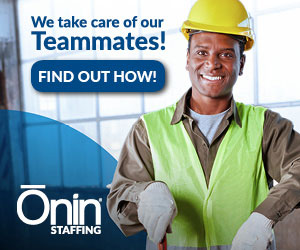OSHA’s Temporary Worker Initiative focuses on the safety and health of temporary workers. Providing safety education and standards for staffing agencies and their client companies ensures temporary workers receive the same protection as permanent employees.
All workers have a right to a safe and healthy workplace. These rights are essential in manufacturing and light industrial work environments, which can be more hazardous than others.
Staffing agencies and client companies are joint employers of temporary workers. Therefore, both are responsible for providing and maintaining a safe work environment complying with the Occupational Safety and Health Act of 1970 (OSH Act) requirements.
Importance of OSHA’s Temporary Worker Initiative
Although the extent of responsibility for staffing agencies and client companies depends on the facts of each case, both parties are jointly responsible for maintaining a safe and healthy work environment for temporary workers. For instance, staffing agencies and client companies must fulfill OSHA’s training, hazard communication, and recordkeeping requirements. Therefore, OSHA can hold the staffing agency and its client company responsible for any violative condition(s), such as inadequate training regarding workplace hazards.
OSHA’s Concerns About Temporary Workers
OSHA’s concerns about the use of temporary workers include:
- Client companies might use temporary workers to avoid meeting compliance obligations under the OSH Act and other worker protection laws.
- Temporary workers get placed in various jobs, including hazardous ones.
- The workers are more vulnerable to workplace safety and health hazards and retaliation than permanent employees.
- Temporary workers might not receive adequate safety and health training or explanations of their duties.
As a result, staffing agencies and client companies must comply with relevant OSHA requirements.
These best practices help staffing agencies maintain compliance with OSHA’s Temporary Worker Initiative.
Clarify Health and Safety Responsibilities
Staffing agencies and client companies should define their roles in maintaining health and safety standards for temporary workers. Understanding who is responsible for specific responsibilities ensures compliance with applicable OSHA standards.
For instance, if a temporary worker’s job requires personal protective equipment (PPE), the contract should state the equipment needed and whether the staffing agency or client company will provide it.
Including these terms in contracts clarifies the agency’s and company’s obligations to fulfill regulatory requirements.
Staffing agency responsibilities
In most cases, the staffing agency is responsible for general health and safety training for temporary workers:
- Temporary workers must be able to identify hazardous situations; report hazards, injuries, and illnesses; and understand their rights if experiencing a hazardous situation at a worksite.
- The staffing agency must ensure the client company provides temporary workers with site-specific training.
- The agency must have a reasonable basis for believing the company’s training adequately addresses the potential worksite hazards temporary workers could encounter.
- If the staffing agency reasonably believes the site-specific training is inadequate, it should inform the client company and collaboratively determine adequate training.
- The agency might agree to provide site-specific training if familiar with the worksite hazards.
- The staffing agency may conduct a worksite walkthrough to identify the tasks temporary workers will perform and any potential hazards.
- The agency can remove temporary workers from the worksite if adequate training is unavailable or not provided.
Client company responsibilities
In most cases, the client company is responsible for site-specific safety and health training:
- The client company generally controls the details, means, methods, and processes by which the work is accomplished.
- The company is familiar with the hazards of the job, machinery, equipment, and worksite processes.
- The client company understands the training required to protect workers from hazards.
- The presence of a staffing agency representative at the work site does not transfer onsite training responsibilities to the agency.
Minimize Workplace Hazards
Although staffing agencies might provide temporary workers with general safety and health training, client companies should provide training customized to the workplace equipment and hazards. Preventing and correcting hazards helps maintain compliance with OSHA standards:
- Communication between the staffing agency and the client company is required to provide the necessary protection.
- The staffing agency must inquire about the conditions of the workplaces to which temporary workers are assigned to ensure safety.
- The agency should determine the client company’s potential workplace hazards and how to ensure protection for temporary workers.
- The staffing agency must verify the client company has fulfilled its responsibilities to provide a safe workplace.
- The client company must treat the temporary workers like permanent employees through safety and health training and protection.
- Ignorance of workplace hazards does not release the staffing agency or client company from maintaining OSHA’s safety and health requirements.
Train Temporary Workers
Staffing agencies and client companies share the responsibility for training temporary workers:
- Training must be in a language and vocabulary the temporary worker understands and be completed before work begins.
- General and specific training requirements depend on the industry, work site, and assigned job duties.
- Both the staffing agency and client company must understand the applicable OSHA standards and specific training requirements.
- The client company may decide whether to divide the training responsibilities.
- Whereas the staffing agency typically is responsible for general safety and health training, the client company typically is responsible for site-specific training.
- The staffing agency and client company should establish which party is responsible for each training requirement and clearly state the details in the contract.
- Each party should inform the other when the training is completed.
- The temporary worker must know how to safely perform their work, identify hazards, and understand control and protective measures.
Maintain Recordkeeping
Staffing agencies and client companies must train temporary workers on the recordkeeping systems to promptly report work-related accidents, injuries, and illnesses:
- The employer supervising the temporary worker daily, typically the client company, must record temporary workers’ job-related accidents, injuries, and illnesses.
- The staffing agency should maintain frequent communication with its temporary workers and the client company to ensure accidents, injuries, and illnesses are properly reported and recorded.
- Open communication alerts the staffing agency to the worksite hazards and whether additional protective measures are needed.
- Information about workplace accidents and investigations helps prevent future injuries and illnesses.
- The case outcomes impact the staffing agency’s administrative requirements and decisions regarding placing other temporary workers with the client company.
Let’s Build a Safer, Stronger Workforce—Together
Sources:





